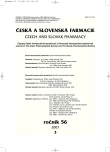HPLC separation of enantiomers using chiral stationary phases
Authors:
D. Meričko 1; J. Lehotay 1; J. Čižmárik 2
Authors‘ workplace:
Faculty of Chemical and Food Technology, Slovak University of Technology Bratislava, Institute
of Analytical Chemistry, Slovak Republic
1; Faculty of Pharmacy, Comenius University Bratislava, Department of Pharmaceutical Chemistry
Slovak Republic
2
Published in:
Čes. slov. Farm., 2007; 56, 107-113
Category:
Review Articles
Overview
During recent few years, separations of enantiomers have become one of the most important analytical tasks. Modern separation techniques, such as the chromatographic ones, represent a very powerful tool in this respect and nowadays they are commercially and widely used all over the world. The importance of enantioseparation must be emphasized, not just because of drugs, food additives, and pesticides, but also because of other compounds which affect our life. The use of direct chromatographic enantioseparation seems to be a suitable approach not just in the analytical but also the preparative scale. This paper is focused on the separation of enantiomers using the chiral stationary phase as one of the ways of how to perform direct chromatographic separation.
Key words:
HPLC – chiral separation – enantiomers – chiral stationary phases – optically active compounds
Labels
Pharmacy Clinical pharmacologyArticle was published in
Czech and Slovak Pharmacy

2007 Issue 3
Most read in this issue
- Naphthoquinones and their pharmacological properties
- Thermoplastic granulation as an alternative method for the preparation of hydrophiliclipophilic oral matrix tablets
- Chitosan in topical preparations
- Medicinal preparations in a manuscript of a fifteen-century Franciscan monk in Brno
